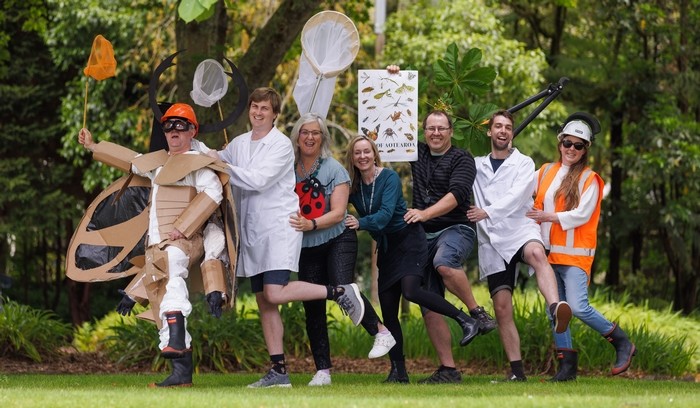Move over birds – it’s time for Bug of the Year
For immediate release
15 November 2022
A public campaign is under way to find New Zealand’s most-loved bug and Scion scientists are all over it like the proverbial moth to a flame.
Voting for the inaugural Bug of the Year competition officially opened this week, with Scion entomologists in Rotorua and Christchurch divided over which of the 24 nominees is most deserving of the 2023 title.
“These are among New Zealand’s most iconic and charismatic native insects” says senior entomologist Toni Withers. “Even for professionals like us who have made careers out of studying insect behaviour for the benefit of the environment and forest biosecurity, it’s impossible to predict which bug will capture the hearts and minds of the nation.”
Following in the footsteps of the very popular Bird of the Year competition run by Forest & Bird, the Bug of the Year contest aims to shine the light on insects and the role they play in New Zealand’s ecosystem. The contest was recently unveiled at the Entomological Society of New Zealand’s 70th annual conference in Rotorua, where Scion scientists shared their research with other academics and amateur bug-lovers over three days.
Aotearoa is home to more than 20,000 named species of insects and spiders and it’s hoped the contest will spark conversation and a new appreciation for bugs that many Kiwis take for granted. The shortlist of contenders was created by a sub-committee of the Entomological Society and includes a variety of invertebrates, including ants, beetles, flies, cicadas and even a spider.
Scion’s portfolio leader, Andrew Cridge, says Bug of the Year has the ability to capture the imagination of people young and old and inspire the next generation of entomologists. He’s picking the Pūriri moth (Aenetus virescens) will be a strong contender.
“It’s the largest endemic moth in New Zealand and is only found in the North Island. It’s always popular with kids; I get sent pictures of these from insect-loving school children.”
Entomologist Belinda Gresham is also backing the Pūriri moth, which only lives for a few days as an adult. “They’re soft and beautiful creatures and until recently, they were also quite mysterious because little was known about how they spent their early lives as larvae burrowed into trees where they live for several years before emerging.”
Renowned beetle expert Carl Wardhaugh has surprised his Scion colleagues by bypassing beetles on the shortlist and giving his top vote to the antlion. The elegant-looking insect with the fierce sounding name (Weelus acutus) can be found on Scion’s Rotorua campus. Its larvae live at the bottom of dusty pits, often in the shadows of trees, waiting for other insects to fall inside and become their next meal.
“Larvae have humongous jaws and as an ambush predator behave like the giant, sand-dwelling Sarlacc characters in Star Wars: Return of the Jedi.”
Childhood memories of growing up in Hamilton and hearing the noise of cicadas in local forests have inspired senior technician Mike Davy to vote for the chorus cicada (Amphipsalta zelandica) one of 42 known endemic cicada species in Aotearoa. “They’re always the soundtrack to summer.”
Entomology team lead Stephanie Sopow, who led a successful biosecurity project that found a biological control for the unwanted giant willow aphid, only has to spend time in her garden to find her top pick for Bug of the Year – the New Zealand praying mantis (Orthodera novaezealandiae).
“They become my gardening companions and I see both the New Zealand and South African species.”
The New Zealand species have a characteristic blueish spot on the inside of their front legs and the males are considered under threat from South African females who eat them during mating.
Toni Withers, meanwhile, is firmly in the camp of ‘Team Dragonfly’, casting her top vote for Carove’s giant dragonfly (Uropetala carovei). It can often be seen darting around Rotorua’s Whakarewarewa Forest over summer.
A good indicator of stream health, the larvae are predatory and live in the muddy banks of streams. “They’re also incredibly unique for their ability to breathe in both water and air,” says Toni. “Lots of physiologists have studied them for their novel gut oxygen membrane system.”
Scientist Andrew Pugh, however, is championing the critically endangered Canterbury knobbled weevil (Hadramphus tuberculatus) and is encouraging all Kiwi bug-lovers to do the same.
Known to live on speargrass in Canterbury, it was considered extinct after no credible sightings of the weevil since 1922. Then in 2004 a university student rediscovered it at Burkes Pass Scenic Reserve near Lake Tekapo. Nearly two decades on, the health of its population is unclear, says Andrew.
“Rats, hedgehogs, rabbits and habitat loss make it one of the most threatened insects in New Zealand today.”
Like Bird of the Year, the Bug of the Year competition is not without controversy. For the Rotorua scientists, the blood-sucking sand fly (Austrosimullium australense) is an unpopular choice. The Southern Michellan ant (Amblyopone australis) has also ruffled feathers because it’s not native to New Zealand.
“Our Christchurch team is aghast at the inclusion,” says Andrew. “But we’ll let democracy take its course.”
People can vote for up to three nominees. Voting closes on 13 February and the bug that receives the most votes will be crowned the Bug of the Year for 2023. The winner will be announced on Valentine’s Day.
Visit https://bugoftheyear.ento.org.nz
ENDS

